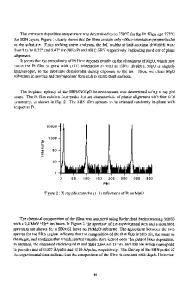Chemical vapor deposition of Sr 1-x Ba x Nb 2 O 6 thin films using metal alkoxide precursors
- PDF / 420,036 Bytes
- 7 Pages / 612 x 792 pts (letter) Page_size
- 83 Downloads / 402 Views
A novel two-step metalorganic chemical vapor deposition process was used in this study to prepare Sr1−xBaxNb2O6 (SBN) thin films. Two thin layers of single-phase SrNb2O6 and BaNb2O6 were deposited alternately on a silicon substrate, and the solid solution of SBN was obtained by high-temperature annealing. The stoichiometry control of the SrNb2O6 and the BaNb2O6 thin films was achieved through deposition process control, according to the evaporation characteristics of double metal alkoxide. The evaporation behavior of double metal alkoxide precursors SrNb2(1-OC4H9)12 and BaNb2(1-OC4H9)12 was studied, and the results were compared with the evaporation of single alkoxide Nb(1-OC4H9)5.
I. INTRODUCTION
Strontium barium niobate, Sr1−xBaxNb2O6 (SBN), with a tungsten bronze crystal structure, is a promising material for optoelectronic applications. Common applications of SBN include using Sr0.6Ba0.4Nb2O6 as a low-voltage light modulator,1 Sr1−xBaxNb2O6 (0.25 < x < 0.5) as a fast infrared (IR) radiation detector,2 Sr0.75Ba0.25Nb2O6 with a photoinduced phase transition as an optical information storage device,3 and surface acoustic wave filters.4 Important properties of the tungsten bronze structure of SBN include its large pyroelectric coefficient, excellent piezoelectric and electro-optic properties, and photo refractive sensitivity. SBN has been extensively studied in the past 20 years.5 SBN modified by rare-earth or alkali ions also has been investigated to improve its properties.6,7 SBN single crystals have been grown mainly by the Czochralski method.8–10 However, the congruent melt composition of SBN is x ⳱ 0.6.9 The growth of single-crystal Sr1−xBaxNb2O6 with a composition other than x ⳱ 0.6 is usually difficult. On the other hand, control of the Sr/Ba molar ratio without impurity is very important to optimize the properties of SBN.4 Recently, several different film fabrication methods have been tried to grow SBN thin films, such as liquid-phase epitaxy of SBN film on SBN (x ⳱ 0.6) substrate using vanadium-containing flux, 11 RFsputtering of SBN film on silicon substrate,12 and sol-gel processing of SBN film on various substrates.4,13–16 The precise control of composition is usually difficult using flux or sputtering growth techniques. Although sol-gel processing features high purity, good homogeneity, easy composition control, and low processing temperature, it is not applicable for continuous and large-area film growth. Among all the reported deposition methods, 1702
http://journals.cambridge.org
J. Mater. Res., Vol. 15, No. 8, Aug 2000 Downloaded: 19 Mar 2015
metalorganic chemical vapor deposition (MOCVD) has the greatest advantages because of its excellent film uniformity, compositional control, high deposition rates, and amenability to large wafer-size scaling. However, little has been reported on the application of MOCVD for the fabrication of SBN thin films. The autostoichiometric MOCVD technique was introduced in our previous papers.17–19 This is an inherently stoichiometric vapor-deposition process, in whi
Data Loading...











